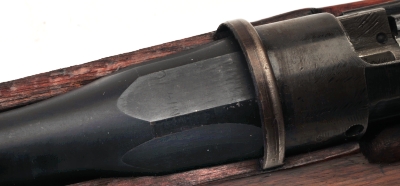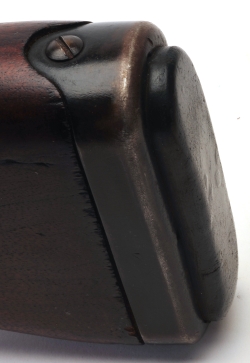
I have always passed on owning a British Enfield for a variety of reasons. The first is the two piece stock that can never be made to look slick as a sporter. the second is the anemic 303 British round and the third is the rifle’s reputation for having a less than robust action that is rated for only moderate pressure levels.
The No.5 MK1, the jungle carbine is a bit different, even if it is chambered for the same mundane cartridge and has an even more fragile action. On the plus side, the No.5 has a short barrel, it’s very compact and it weighs only seven pounds. If the No.4 speaks Posh, the No.5 speaks Cockney. It is a junk yard dog of a rifle, like the M38 Nagant or the Steyr M.95 Mannlicher or the Ruger Scout Rifle. Lots of bark, respectable bite and they all tap you on the shoulder with conviction. The problem with finding a good No.5 is that some folks have taken to converted No. 4 rifles into jungle carbines and some companies have manufactured civilian versions, post 1947, to capitalize on the demand for these little guns. Fortunately, a firearm can be checked for attributes specific to the No.5 to tell if it is the real deal or a knock off, in addition to firearm markings.
Overall, from the end of the rubber butt plate to the tip of the flash suppressor, the carbine is 39.5″ long. The actual barrel length, net of the suppressor, is 18.5″. The forend may be capped, depending on the issue and the stock band is 7.75″ forward of the receiver. All No.5 Mk1 rifles were made with a bayonet lug beneath and integral to the flash suppressor. This gun’s lug has been milled off. Something, unfortunately, that has been done to many of these rifles.

The carbine is lightened, in comparison to the No.4, through reduction of wood and metal. Above, the No.5 barrel is scalloped just ahead of the receiver. The top of this barrel is stamped “M/47C” which identifies it as one of 81,000 guns produced at the BSA Shirley facility.
Below, The receiver sides have been scalloped and the bolt handle is hollowed to reduce weight. The No.5 Mk1 was issued with a flip up, screw adjustable back sight incremented to 800 yards. The M/47C stamp indicates BSA manufacture, 1945 is the year of manufacturer and the very light remains of an 8748 serial number is the correct four digits.

Yes, the electro pencil marking on the receiver looks pretty cheesy, but it is a correct mark. Below, a little more rear sight detail. Down it is a peep sight, flipped up it is a precision long range sight with a reduced aperture.

Below – All No.5 Mk1 carbines have a bayonet lug projecting downward from the its flash suppressor. Rifles pressed into civilian hunting service often have the lug removed for a cleaner appearance and to have one less projection to get tangled in branches. The front band on a No.5 is 7.75″ forward on the handguard while converted No.4s are typically at the rifle’s standard 10″.



Under the handguard there is another barrel stamp that indicates cartridge, case or chamber length, barrel length and proof marks. This is a struck mark rather than an electro pencil scribe.
For anyone who thinks the British don’t have a sense of humor beyond, Benny Hill and Rowan Atkinson, there is the reference to this piece being called a soft rubber recoil pad. I particularly like the way the contact surface was narrowed to reduce load spreading. Sarcasm.
There are many reproduction parts for this rifle and many sources of original parts. Key to establishing a particular firearm as an authentic No.5 Mk1 is that all of these unique badges are present and not just one. Proper No.5 Mk1 with incorrect leather, rather than web carry sling.


Email Notification